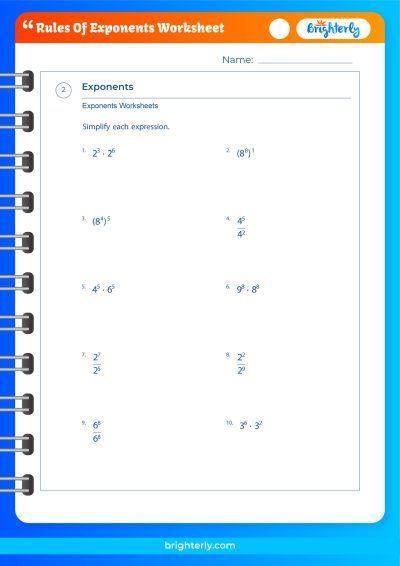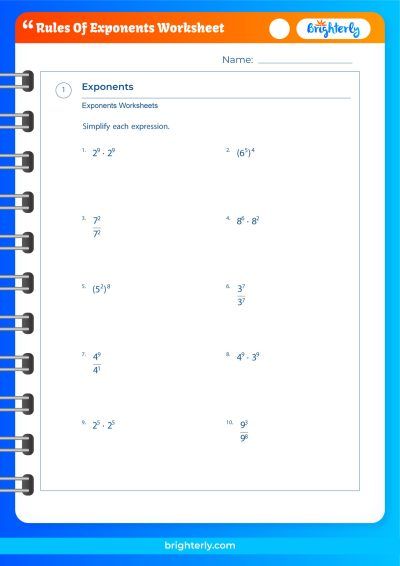Exponent Rules – Definition with Examples
Updated on January 4, 2024
Welcome to another exciting learning journey with Brighterly! We’re on a mission to simplify complex mathematical concepts for children. Today, we’re delving deep into the world of exponent rules – an integral part of mathematics that helps us tackle multiplication of numbers in a more simplified manner. It’s all about raising numbers to the power of others! We’re going to demystify these rules, explore practical examples, and even answer some frequently asked questions to make sure you understand everything. So sit back, grab your notebooks, and let’s learn together in the classic Brighterly way, turning complexity into simplicity!
What are Exponent Rules?
Exponent rules, often known as the laws of exponents, are guidelines in mathematics that dictate how we work with exponents. Exponents are a way of expressing multiplication of a number by itself a certain number of times, presented as a small, superscript number. The use of these rules makes it easier to handle exponents during mathematical calculations, particularly in higher-level mathematics like algebra.
At Brighterly, we believe that practice is the key to mastery. That’s why we invite you to explore our exponent rules worksheets, where you can find an array of additional practice questions, complete with answers.
Exponent Rules and Explanation
There are several exponent rules that guide how we solve equations involving exponents. Let’s look at these rules one by one.
Zero Rule
The Zero Rule states that any number (except zero) raised to the power of zero is always one. This means if you have an equation like 5^0, the answer will be 1. The concept behind this rule is based on patterns in mathematics.
One Rule
Next, the One Rule explains that any number raised to the power of one equals itself. This might seem simple, but it’s an essential cornerstone of the laws of exponents. So, for 7^1, the answer will be 7.
Negative Rule
The Negative Rule posits that any number raised to a negative exponent equals one divided by that number raised to the opposite positive exponent. For example, 3^-2 would equal 1/3^2, or 1/9.
Product Rules
The Product Rule of Exponents states that when you multiply two numbers of the same base, you can add the exponents. For instance, 2^3 * 2^4 becomes 2^(3+4), which equals 2^7 or 128.
Quotient Rules
For the Quotient Rule, when you divide two numbers of the same base, you subtract the exponents. In other words, 5^4 / 5^2 becomes 5^(4-2), which simplifies to 5^2 or 25.
Laws of Exponents
These exponent rules we’ve discussed are sometimes called the Laws of Exponents, and they have a few more sophisticated friends! Let’s look at them in detail.
Power of a Power Law of Exponents
The Power of a Power Law states that if a power is raised to another power, you multiply the exponents. Therefore, (3^2)^4 would become 3^(2*4), or 3^8.
Power of Product Rule of Exponents
The Power of Product Rule explains that if a product is raised to a power, each part of the product is raised to that power. An example is (2*3)^4, which equals 2^4 * 3^4.
Power of a Quotient Rule of Exponents
The Power of a Quotient Rule states that if a quotient is raised to a power, both the numerator and the denominator are raised to that power. So, (4/2)^3 would equal 4^3 / 2^3.
Fractional Exponents Rule
The Fractional Exponents Rule indicates that an exponent as a fraction, where the numerator represents power and the denominator represents root. For example, 8^(2/3) is equivalent to the cube root of 8 squared.
Exponent Rules Chart
An Exponent Rules Chart is a fantastic tool that visually represents the different rules we’ve discussed. It is a quick-reference guide that helps you remember the laws of exponents. For example:
- Zero Rule: Any number (except 0) raised to the power of 0 is 1.
- One Rule: Any number raised to the power of 1 is itself.
- Negative Rule: A number raised to a negative exponent equals 1 divided by that number to its positive exponent.
- Product Rule: When multiplying like bases, add the exponents.
- Quotient Rule: When dividing like bases, subtract the exponents.
- Power of a Power Rule: When raising a power to a power, multiply the exponents.
- Power of Product Rule: A product raised to a power equals each part of the product raised to that power.
- Power of Quotient Rule: A quotient raised to a power equals both the numerator and denominator raised to that power.
- Fractional Exponents Rule: An exponent as a fraction denotes power/root, e.g., x^(a/b) equals bth root of x to the power a.
Exponent Rules Examples
Visual learners benefit greatly from examples. Here are a few to illustrate the laws of exponents:
- Zero Rule: 7^0 = 1
- One Rule: 5^1 = 5
- Negative Rule: 2^-3 = 1/(2^3) = 1/8
- Product Rule: 3^2 * 3^5 = 3^(2+5) = 3^7 = 2187
- Quotient Rule: 10^6 / 10^3 = 10^(6-3) = 10^3 = 1000
- Power of a Power Rule: (2^3)^4 = 2^(3*4) = 2^12 = 4096
- Power of Product Rule: (2*3)^4 = 2^4 * 3^4 = 16 * 81 = 1296
- Power of Quotient Rule: (6/2)^3 = 6^3 / 2^3 = 216 / 8 = 27
- Fractional Exponents Rule: 16^(1/2) = √16 = 4
Practice Questions on Exponent Rules
Practice is an essential part of the learning process. Here are some practice questions to test your understanding of the exponent rules:
- Calculate: 2^0 * 2^6
- What is 9^-1?
- Find the value of (3^2)^3.
- If (x^3)^2 = x^6, find the value of x.
- Calculate: (4*2)^3
Conclusion
Well done, young scholars! You’ve journeyed with Brighterly through the world of exponent rules and come out the other side. Not only have you gained new knowledge, but you’ve also empowered your mathematical toolbox. This knowledge will serve as a building block for more advanced math topics you’ll encounter in your academic journey. But remember, learning doesn’t end here. Keep practicing, and make the most of these rules. And as always, Brighterly is here to illuminate your path to knowledge. Keep the curiosity alive!
Frequently Asked Questions on Exponent Rules
Here are some frequently asked questions about exponent rules, answered to enhance your understanding:
What is the exponent in math?
An exponent refers to the number of times a number, known as the base, is multiplied by itself. For example, in 2^3, 2 is the base and 3 is the exponent, which means 2 is multiplied by itself three times (2 * 2 * 2).
What does a zero exponent mean?
According to the Zero Rule of exponents, any non-zero number raised to the power of zero is 1. This rule is based on the patterns observed in the powers of numbers.
What does a negative exponent do?
The Negative Exponent Rule states that any number raised to a negative exponent equals 1 divided by that number raised to the opposite positive exponent. Essentially, it reciprocates the base number.
What happens when you multiply exponents?
When you multiply numbers with the same base, the exponents get added. This is known as the Product Rule of exponents.
What about dividing exponents?
When you divide numbers with the same base, you subtract the exponents, according to the Quotient Rule of exponents.
What is a fractional exponent?
A fractional exponent refers to an exponent that is a fraction. The numerator represents power, while the denominator signifies root, according to the Fractional Exponents Rule.
We hope these answers shed light on any uncertainties you had about exponent rules. With Brighterly, learning is a delightful journey!






